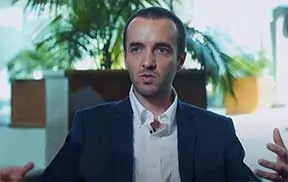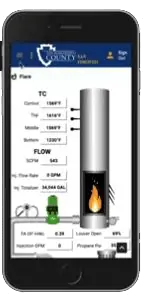

When Doug Doerr got a call from a Colorado-based landfill operator with a hot gas probe at his site’s boundary, Doerr’s day kicked into high gear. Chasing down gas migration problems is nothing new in an SCS client manager’s life, but that reality makes the job no less complex. And in this scenario, he was dealing with a site that he occasionally got called to visit, so to understand the problem fast, he needed the site’s historical data and the current information to fully picture what was happening.
Doerr started with basic landfill gas information from the client: the monitoring probe’s location and a drawing of the gas collection system to determine where the probe was in relation to the gas system. But as you know, that is one small slice of a king-sized pie.

“I queried our in-house landfill gas technical group (engineers, geotechnical experts, and field personnel). And got over 25 responses within several hours with suggestions, one of which came from Ken Brynda in SCS Field Services, who leveraged DataServices to help me identify and narrow down the potential cause of the problem,” recalls Doerr.
DataServices, a module of the SCS eTools® digital platform, collects, stores, manages and analyzes large volumes of continuously accumulating landfill gas data for individual sites or multiple landfills. The module provides a quick method to view landfill gas scenarios.
The beauty of it is that it generates maps and charts to visualize every well and every probe. These system components are viewed in relation to one another and in relation to the perimeter, where the methane on that Colorado site flowed. Further, SCS Field Services’ landfill gas gurus, such as Ken Brynda, plug-in specific parameters that keep a close watch on any well or a group of wells.

As responders viewed initial results from their respective bases around the country, Brynda churned out more information in a few hours, running point charts to capture the balance gas, methane, flow, temperature, supply vacuum, and the vacuum applied to each well. He looked for trends that narrow down cause and point to solutions.
Eliminating the Possibilities – Rule Out Well System Malfunctions
“It can take days if we’d had to do it the old school way with spreadsheets laid out in a lot of rows. But we could identify the potential problem in a matter of hours, backed by a comprehensive evaluation for the landfill operator in eight hours,” Doerr says.
When Field Services staff work to solve a problem with a probe, they look for an outlier, something from a group of wells that’s not behaving like the other wells. In this case, Brynda determined that the wells near the hot probe were functioning properly. DataServices eliminated potential problems by slicing through and analyzing large chunks of data confirming the system was working efficiently.
Next, we observed that the wells are likely too far away to pull gas back from waste, adjacent to the probe in question, where there are no wells.
“DataServices helped rule out malfunctions, and that’s a big deal because if you can confirm the landfill system is working properly, you have narrowed your focus and can look toward other possibilities, ultimately leading to corrective options,” Doerr says. Brynda and Doerr suggested putting in temporary wells in that area to avoid odor migration and health and safety issues.
Doerr continues watching the situation and is prepared with a several-point action plan to mitigate exceedances and avoid falling out of compliance. “We continue watching the data to ensure the gas collection system continues to function well. Should there be issues again, we’re able to fully identify the gas migration pathways and anything in the system that looks out of the ordinary,” Doerr says.
If the client decides to add wells in time, data from the expanded infrastructure will be added to the app and monitored. “As the number of wells grows, DataServices grows with it, adding any, and as much, monitoring and collection data as the operator wants. DataServices will always be in the background to monitor, collect and analyze LFG data in real-time, whenever we need it,” he says. Being able to store, organize, dissect and analyze unlimited volumes of information from one location is powerful. And not just because it helps operators identify problems as they are happening, but because it and our teams can support them in looking for trends over time. Keeping an eye on the activities that keep the systems in balance is less costly.
For Doerr, who spends time in the field but longer hours with his clients, DataServices and the ability to interact quickly with experts like Brynda help SCS deliver more value to clients. “As much as I’d love to master DataServices, I need to focus all of my time on my clients’ business and goals; having support from Field Services and DataServices makes us all more efficient.”
Landfill Technologies and Comprehensive Expertise
SCS eTools® and SCS DataServices®, now with SCS MobileTools® for viewing data and charts anywhere; available to pull landfill data into DataServices for analyzing. You can customize and focus on exactly what you need fast. As Doug and Ken emphasize, it’s info that you likely already have, but may not be able to use quickly for troubleshooting.
SCS RMC®, remote monitoring and control of landfill equipment and systems.
Comprehensive Landfill Services
Our industry is in a period of a rapid transition to digital data management, but particularly on landfills. Often you read that the latest technology, whether by a brilliant programmer or rolling out as part of a takeover, is innovative. Linking technology and innovation is becoming commonplace, but they are not the same. Innovation is a human process requiring experimentation and iteration to solve landfill issues that often have nothing to do with computers or mobile phones. Landfill technology or apps are tools.
Innovation takes a team of diverse expertise, different perspectives with a constant desire to learn, and most importantly, the primary desire to make landfill operations more efficient and safe. Innovators use technology when and how it makes sense to improve environmental management, profitability, and care for employees and the local community. Lower cost solutions for the vast amount of data collection completed faster and without human error come from people with hands-on in-the-field experience. When it comes to landfill technology, its value is clear when a landfill practitioner demonstrates how the particular technology fits into a solution. The nice part is they also get to the point and skip the tech-speak and jargon.
The Landfill Technology Evolution Started Here in 2003
Back in 2003, SCS couldn’t find technology that would enable our engineers and technicians to support landfill operations as we desired. Proving the proverb “necessity is the mother of invention,” we developed a database for our use. Its value in the field was immediate, and SCS continued to adapt and develop SCS DataServices® and SCS MobileTools®, basing refinements on each landfill and client need. It took people in the waste industry to make the right technology tools for the industry.

Meet Oliver Early, SCS’s DataServices and MobileTools Product Manager. Oliver started his career managing landfill operations. He became interested in technology because it got results for him as a landfill manager of 15 facilities. By combining a comprehensive investigation of physical landfill systems, such as landfill gas collection and control and other environmental monitoring and control systems with evaluations of compliance areas, he improved his landfill system performance and substantially increased power plant production. He used multivariate data techniques, including time series and network analysis, to scrutinize and refine results. Merging DataServices capabilities under Oliver’s guidance took SCS’s original internal database to a timesaving product for all landfills, not just the landfills SCS operates.
The platform, called SCS eTools®, includes modules for leachate, groundwater, DataServices, and the newest application SCS MobileTools, free for those using DataServices. The technology is currently in use on over 630 landfills nationwide and benefits all of SCS’s design, build, and operations work.
For example, if methane readings at a gas probe are elevated, that’s an indication of a potential LFG migration issue. While expertise is great – it could take hours to diagnose and mitigate. With DataServices, you could run an evaluation of the existing well field in a few minutes, ruling out issues with current wells. With the touch of a button, you can share the information with your team and focus on potential mitigation recommendations.
Remote Monitoring and Control Technology Didn’t Happen Overnight Either
The best and most innovative solutions come from combining the stakeholders’ experiences and thoughts. Let’s meet a few of the people who lead other landfill innovations.

In addition to being a licensed drone pilot herself, flying over 100 landfills, Business Manager Melissa Russo uses SCS Remote Monitoring and Control (RMC) technology to support her landfill clients. Her contributions increase safety and lower environmental risk using unmanned aerial vehicles to gather field data at a lower cost. Melissa developed SCS’s national drone and geographic information systems (GIS) programs to respond to her clients’ needs for expensive regulatory and operating challenges. As a result, capturing more (methane) greenhouse gas instead of releasing it into the atmosphere provides the obvious environmental benefits, and landfill personnel have better and safer working conditions.
Depending on the sensor or camera attached, her pilots can monitor methane concentrations using a tunable diode laser, measure and map surface temperatures to mitigate elevated temperature conditions, or create topography, aerial imagery, and estimate filling volumes. Operators can view, detect and measure changes over time, gaining insight into critical infrastructures such as water infiltration, liquid flow, and vegetation distributions. Melissa’s use of GIS provides a low-cost solution to data management and sharing between field and office.
Melissa is an innovator who genuinely cares about our industry, taking the time to listen and truly understand her clients’ challenges and long-term goals. Only then does she devise customized solutions, regardless of whether it uses technology or not. See Melissa at work.
The Internet of Things (IoT) is Bang for Your Buck

SCS RMC’s Business Manager is David Hostetter. His experience includes remote monitoring and controls systems engineering, construction, and operation; landfill gas and leachate engineering; and mechanical engineering. Dave’s focus is on automating remote process control of landfill systems, landfill gas blower/flare stations, wellfield vacuum and flow, along with leachate and groundwater pumping systems, weather equipment, and air monitors.
As a landfill gas engineer, his impetus was to avoid production downtime and keep operations within regulatory mandates. He wanted his clients to see what was happening at any given time and be alerted to atypical conditions. As a landfill engineer, he knows that “prevention is better than cure,” as long as it’s cost-effective. Dave’s solution is to leverage the Internet of Things through SCS RMC systems. Each piece of equipment you want to monitor gets a sensor. His team configures each sensor or group of sensors to parameters based on his operator’s business needs and environmental reporting responsibilities. A local wireless network communicates with a base station providing continuous readings from each sensor.
RMC sends alerts if readings are outside an acceptable range or if an environmental threshold is nearing exceedance. Alerts go to the landfill’s designated staff or technicians via smartphones, computers, or tablets. From these devices, users access their interface to control, start, stop, and reset field systems and analyze system operation. They can also view data, graphs, tables, alarms, and reports.
That’s more than convenience; it saves labor dollars spent to diagnose and reset these systems and is especially valuable for remote landfills. By design, clients can enable custom authorization levels for their systems. Naturally, the analytical tools are easy to use, understand, and report, as he explains in his video.
Albert Einstein Said…
“You can’t solve a problem on the same level that it was created. You have to rise above it to the next level.” We’re not comparing ourselves to Einstein, but all three SCSers leading their teams know that compliance policy never stops changing, and landfills are unique beasts made up of complex systems that need balance to perform. Performance is based on daily decisions and landfill readings generating enormous amounts of data. SCS’s job is to make your job better by collecting those millions of data bits for analysis faster, helping landfill operators use the intelligence to identify the cause and appropriate response to hundreds of issues that are part of landfill or facility management.
The backbone of every service at SCS Engineers is to design and develop based on our clients’ specific needs. As innovators, our mission is to leverage proven technology to meet those needs. As our founders did, we strive to understand our clients’ current and future needs, then develop or integrate the appropriate technology to meet those needs.
SCS is one of the most experienced and successful environmental compliance, design-build, operations, and maintenance firms in the United States. No stand-alone technology company can substitute for our knowledge and hands-on experience with innovative landfill design, build, and operations.
Visit SCS Engineers to discover SCS eTools and SCS RMC capabilities. You’ll find case studies, technology awards, and more resources for using technology to manage labor, liquids, air monitoring, groundwater, volume, GHGs, and more
The Ignition Firebrand Awards recognize system integrators and industrial organizations that create innovative industry solutions.
SCS Engineers and partner Corso Systems jointly received a 2019 Firebrand Award yesterday at the annual Ignition Community Conference. The firms won recognition for their next-generation visualization and control system for landfills.

After flying the San Timoteo Landfill, uploading the imagery, and mapping the facility, they embed both the 2D images and 3D rendering into Perspective. The team can take those rendered images and apply them into a Microsoft HoloLens VR headset as well, which allows decision-makers at San Bernardino County to “walk the site” from their offices. Now, landfill executives and operators can view their sites remotely from any device, anywhere. Other benefits include:
The firms and SCS RMC® have received a tremendous amount of positive feedback. SCS RMC® is now rolling out similar solutions at more landfills, for pipelines, and other industrial applications. A video on the 2019 ICC Award website explains how the system works and what landfill owners and operators can expect.
Well done and congratulations on providing superior client service!